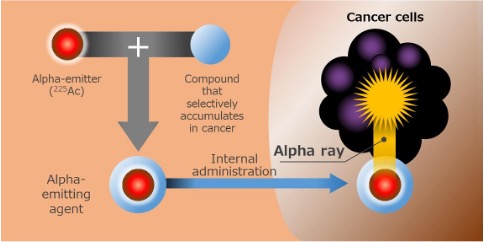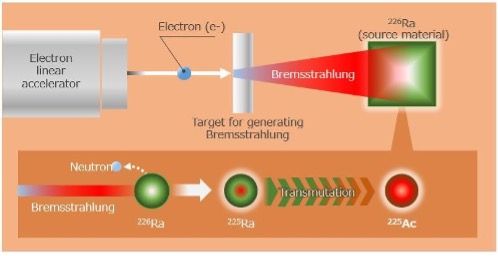|
Hitachi, Tohoku University and Kyoto University Become World's First to Establish Technology for Highly Efficient, High-quality Production of Actinium-225, a Material Required for Internal Radiation Therapy Called TAT
Helping to expedite the commercialization of a type of radiation therapy that is effective against cancer which has spread widely through body
TOKYO, Oct 19, 2021 - (JCN Newswire) - Hitachi, Ltd. (TSE: 6501), Tohoku University and Kyoto University have become the world's first (1) to establish technology for the highly efficient and high-quality production of actinium-225 (225Ac), a substance required for a form of radiation therapy known as targeted alpha therapy (TAT). TAT is a new cancer therapy which combines a substance that emits alpha particles which destroy cancer cells with a compound that selectively accumulates in cancer cells. The combined alpha-emitting agent is administered to a patient to attack cancer cells within the body (Figure 1). It is known to be effective against forms of cancers that are difficult to treat with existing methods of treatment, including cancer cells that are spread widely through the body, and its practical applications are eagerly awaited. The three-party team has now established technology that enables production of high-quality 225Ac in an efficient manner without producing impurities, which are usually difficult to separate, by using an electron linear accelerator (2) with radium-226 (226Ra) as a source material.
Hitachi, Tohoku University, and Kyoto University will continue research and development efforts to bring this production technology into commercial use, to help put TAT into clinical practice and ultimately improve cancer patients' quality of life (QoL). In addition, Hitachi is set to start a study to evaluate the applicability (3) of 225Ac produced using this new technology in pharmaceutical products in October 2021 in collaboration with the National Cancer Center Japan. Hitachi makes effort to pursue research and development that promotes the Security & Safety (healthy and comfortable life for each individual) of society.
 | | Figure 1: Principle of targeted alpha therapy(TAT) | | |
 | | Figure 2: Method of 225Ac production using an electron linear accelerator | | |
Types of radiation therapy include external and internal. External radiation uses beams of radiation delivered outside the body to target cancer cells, while internal radiation involves internal delivery of radiation. TAT is a form of treatment in which alpha-emitting agents are administered into the body to selectively target cancer cells, while producing fewer side effects. It is a potentially promising form of treatment especially for cancers that are difficult to treat with existing methods, including advanced cancer where cells are spread widely through the body. Following a report*4 of its high therapeutic effects in patients with metastatic prostate cancer, therapies using 225Ac as an alpha-emitter have been studied for their efficacy and safety in clinical trials (5) across the world. However, the only established method of producing 225Ac that has been one that uses thorium-229, a nuclear material (6) that is difficult to handle, and it produces only a small amount of 225Ac (63 GBq/y).(7) This has posed obstacles to any widespread use of TAT, as 225Ac is not available in a sufficient amount.
To tackle the situation, Hitachi, Tohoku University's Research Center for Electron- Photon Science, and Kyoto University's Institute for Integrated Radiation and Nuclear Science have joined forces to develop a method of producing 225Ac that does not involve nuclear material by applying technologies Hitachi has accumulated in the fields of particle therapy and nuclear power generation. Together, they have successfully established for the first time technology for highly efficient and high-quality production of 225Ac that uses an electron linear accelerator with 226Ra as the source material. This production method involves the use of highly penetrating bremsstrahlung radiation (8) to irradiate 226Ra. In addition to being an efficient production method, it also produces high-quality 225Ac because it does not produce impurities that are difficult to separate (Figure 2).
The team has conducted a proof-of-principle test on the production of 225Ac using a small amount of 226Ra, and collected detailed data on 226Ra's photonuclear reactions.(9) Based on the findings from the test, the team, in a joint research project with the addition of researchers from Tohoku University's Institute for Materials Research, who own the technology to handle large amounts of radium, has succeeded in producing approximately 370 kBq of 225Ac, an amount that is sufficient for the future evaluation of its applicability in pharmaceutical products. This represents a major step forward for commercial application of this production method, such that the amount of 225Ac currently produced globally in a year (63 GBq/y) (7) can be produced in one day.(10)
Parts of these results will be shared as a Top Rated Oral Presentation at the 34th Annual Congress of the European Association of Nuclear Medicine, (11) which takes place October 20-23, 2021.
(1) World's first as a technology that uses an electron linear accelerator to produce 225Ac through a photonuclear reaction of
226Ra as a source material.
(2) A type of linear particle accelerator that accelerates electrons to produce a high-energy beam.
(3) An evaluation of levels of efficiency and stability of 225Ac in being bound to drug.
(4) C. Kratochwil et al., J Nucl Med. 2016, vol.57, p1941-1944.
(5) A scientific research method that looks into the efficacy and safety of a new medicine or therapy in healthy adult or patient populations.
(6) A material that makes nuclear fuel in nuclear power stations ( uranium, plutonium, thorium)
(7) A. K. H. Robertson et al., Curr. Radiopharm., 2018, vol.11, p156-172.
(8) Electromagnetic radiation produced by irradiating target metal with high-energy electrons.
(9) A type of nuclear reaction that is caused by high-energy photons (such as bremsstrahlung).
(10) Estimates were made based on the results of simulations using theoretical values of reaction cross -section (reaction probability) and the amounts of 225Ac produced at the proof-of-principle testing.
(11) The 34th Annual Congress of the European Association of Nuclear Medicine (EANM2021). https://eanm21.eanm.org/
About Hitachi, Ltd.
Hitachi, Ltd. (TSE: 6501), headquartered in Tokyo, Japan, is contributed to a sustainable society with a higher quality of life by driving innovation through data and technology as the Social Innovation Business. Hitachi is focused on strengthening its contribution to the Environment, the Resilience of business and social infrastructure as well as comprehensive programs to enhance Security & Safety. Hitachi resolves the issues faced by customers and society across six domains: IT, Energy, Mobility, Industry, Smart Life and Automotive Systems through its proprietary Lumada solutions. The company's consolidated revenues for fiscal year 2020 (ended March 31, 2021) totaled 8,729.1 billion yen ($78.6 billion), with 871 consolidated subsidiaries and approximately 350,000 employees worldwide. For more information on Hitachi, please visit the company's website at https://www.hitachi.com.
About TohokuU's Research Center for Electron-Photon Science
The Research Center for Electron-Photon Science (ELPH) is a research institute affiliated with Tohoku University. Equipped with an electron linear accelerator and an electron booster-synchrotron accelerator, ELPH has a capacity of generating up to 1.3- GeV electron or photon beams and provides them for use in scientific experiments by researchers through the national "Joint Usage" scheme. In addition to promoting research in the structure and nature of materials in a wide range of fields, from quarks and hadrons which are found in atomic nuclei to materials science. ELPH pursues leading-edge research in accelerator science and beam physics to help make it possible to conduct beam-based experiments that are even more advanced.
About TohokuU's Institute for Materials Research
The Institute for Materials Research (IMR) is a research institute affiliated with Tohoku University, which is dedicated to research into scientific principles related to material- based sciences and their applications. By combining science with engineering, IMR is engaged in research and educational activities in the field of materials science, covering both fundamental and applied research.
About KyotoU's Institute for Integrated Radiation and Nuclear Science
The Institute for Integrated Radiation and Nuclear Science at Kyoto University is engaged in isotope application chemistry research and educational activities in a wide range of fields, including physics, chemistry, biology, engineering, agriculture and medicine, using two research reactors (KUR and KUCA) and accelerators, as a designated research center under the Joint Usage / Research Center in National Universities scheme.
Contacts:
For more information, use the enquiry form below to contact the Research &Development Group, Hitachi, Ltd. Please make sure to include the title of the article.
https://www8.hitachi.co.jp/inquiry/hqrd/news/en/form.jsp
Research Center for Electron Photon Science (ELPH), Tohoku University Hidetoshi Kikunaga, Associate Professor
1-2-1 Mikamine, Taihaku-ku, Sendai, Miyagi 982-0826 JAPAN
Phone: +81-22-743-3425
E-mail:kikunaga@lns.tohoku.ac.jp
Laboratory of Alpha-Ray Emitters, Institute for Materials Research, Tohoku University Kenji Shirasaki, Head of Laboratory / Senior Assistant Professor
2-1-1 Katahira, Aoba- ku, Sendai, Miyagi 980-8577 JAPAN
Phone: +81-22-215-2161
E-mail: kshira@imr.tohoku.ac.jp
Institute for Integrated Radiation and Nuclear Science, Kyoto University
2-1010, Asashiro-Nishi, Kumatori-cho, Sennan-gun, Osaka 590-0494 JAPAN
Phone: +81-72-451-2300
Source: Hitachi, Ltd.
Sectors: Healthcare & Pharm, Clinical Trials
Copyright ©2024 JCN Newswire. All rights reserved. A division of Japan Corporate News Network. |